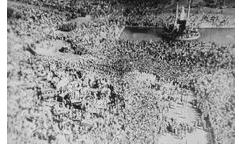Important Questions Test: India After Independence - UPSC MCQ
20 Questions MCQ Test - Important Questions Test: India After Independence
While debating about the language used in the Constituent Assembly, who said these words a warning on behalf of people of the South some of whom threatened to separate from India if Hindi was imposed on them.
Why was the date 26 January 1950 chosen for the new Constitution to come into force ?
The image given below is that of a funeral procession that shook the entire Indian nation on 30 January 1948. Identify the event

Name the Hindu fanatic, who shot and killed Mahatma Gandhiji.
Which day is observed as the Sarvodaya Day every year?
From the image given below, identify the lady (extreme right), Her original name was Madeleine Slade and was a British woman who left Britain, to live and work with Gandhiji and devoted her life on implementing Gandhiji's principles.
Who was the Deputy Prime Minister in the cabinet of the Prime Minister Jawahar Lal Nehru?
With the help of the attached image, name the important leader from Andhra who went on a hunger strike and died later demanding the formation of Andhra State to protect the interests of Telugu speakers, when Nehru went to campaign during the elections of 1952.
When the new state of Andhra Pradesh did come into being?
In which year was the State Reorganisation Committee set up to recommend the redrawing of district and provincial boundaries of many provinces ?
Based on which of the following did India, after the independence, reorganize the states ?
Pick out the year in which the bilingual state of Bombay was divided into separate states for Marathi and Gujarati
Choose the year in which the state of Punjab was divided into Punjab and Haryana.
Name the place in India where the Hindu ruler Maharaja Hari Singh ruled a majority of Muslim people
In which year did Jawahar Lal Nehru establish the Planning Commission?
On which country's model did Jawahar Lal Nehru develop the Five Year Plans?
Name the first President of the Frist Planning Commission established in 1950 ?
The Planning Commission designed and executed suitable policies for economic development based on a ________________ model
Select the year in which the Second five Year Plan was formulated.
Apart from building dams, name the important sector that was focused strongly on the Second Five Year Plan














